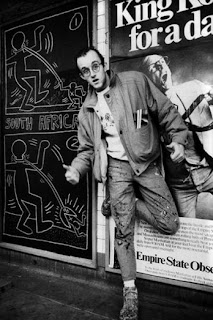American artist Keith Haring was just a toddler when the Berlin Wall was built in 1961. As a child, Haring’s father nurtured his son’s artistic talent, encouraging Keith to draw imitations of cartoon characters, which eventually grew into visual stories, and characters of his own imagination. While attending the School of Visual Arts in New York, Haring gravitated toward the street art subculture which included rap music’s pioneers and graffiti artists. Haring understood the political context of these social messages. Attracted by the immediacy of the style, and its audience, Haring began using chalk to draw in the underground subway system, where his cartoon imagery touched on issues ranging from the crack epidemic to Apartheid. His work evolved into large-scale paintings, then murals and public art, but he came full circle, eventually to human bodies, clothing, and stereos.
The Berlin Wall was a product of the Soviets during Cold War, which stretched from 1945 to 1989. Military and political tension ignited between the Soviet Union and the United States, who were former Allies during World War II, but ideological differences combined with political actors who governed resulted in four decades of conflict. The Soviet Union became occupier of the “Eastern Bloc,” an area that stretched through Poland, Hungary, and Czechoslovakia. The Berlin Wall was an armed symbol, dividing east and west Berlin from August 13, 1961 to October 3, 1990, when it was torn down. Circling 96 miles of a the city, the enclosure was eleven feet high, six feet thick, boasted 44 miles of barbed wire, with guard towers, bunkers, and military roadways. During the course of thirty years, some 5,000 people attempted to defect to the west in spite of the shooting orders issued by the east German government. Though officials denied the claim, it’s been reported that more than 200 people lost their lives trying to cross.
Joseph Stalin conceived the idea for a wall to assert control over the population who were keen to rid themselves of the new occupier. From the time the Soviets took over, nearly 3.5 million Germans (20% of the entire population of East Germany) defected to the Western Allied controlled areas. Stalin foolishly believed the Western Allies---England, France, and the United States would eventually pull out, and his government could control Germany. What he didn’t anticipate was the flight of the intelligentsia to the west, who bore a global movement protesting communist tyranny and the division in their homeland that became fodder for American intervention.
In 1986 Haring, now an established artist in New York, was approached by a man from the Mauer Museum at Checkpoint Charlie to commission a mural on the western face of the Berlin Wall. Founded a year after the wall’s construction, the museum’s mission to “international nonviolent protest,” encouraged Haring to accept the offer. Not a passive artist, Haring was a vocal activist, and creative supporter of human rights.
Haring sought to re-imagine the wall, and nurture those living on both sides of a segregated city. The mural alternated between red and black on yellow, to represent the unity of German colors, stretching 350 feet. Haring painted a continuous interlocking chain of human figures, connected at the hands and feet, facing different directions.
While the piece was not preserved when the wall was torn down in 1990, Haring lived to the work's message become non-fiction. Importantly this, and later public works, along with the work of artist Jean Michel-Basquiat, defined for the mainstream the role of graffiti as a means of visual and textual commentary, forging a place for it formally in the art world. Haring died in 1990 at the age of 31 from AIDS related complications.
Sandra Reed
Houston, Texas
Sources:
Image Sources:
Web search, unknown.






